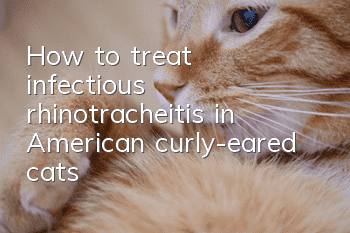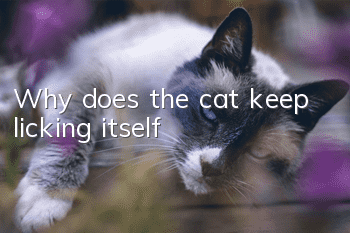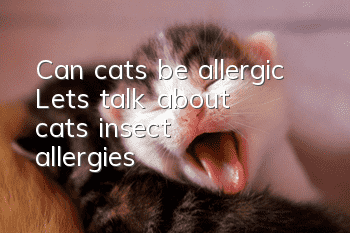How to treat infectious rhinotracheitis in American curly-eared cats?

How to treat infectious rhinotracheitis in American curly-eared cats? Cats can also suffer from this disease. Most of the time, the surrounding environment is not hygienic enough or the cat has been exposed to wild cats carrying germs, so it suffers from infectious rhinotracheitis.
Causes of feline infectious rhinotracheitis
Feline infectious rhinobronchitis, commonly known as feline nasal bronchitis. Anyone who has raised a lot of cats or has taken care of stray cats is familiar with this disease, or has had a painful experience. I have encountered A family adopted a dozen stray cats. Almost all of them were adults and had been vaccinated, but they all still fell ill, and the final mortality rate exceeded 30%.
Most people think that sneezing and runny noses mean cats have a cold. However, if the cat goes out, or the owner comes into contact with stray cats, or the cat is released to another cat group, cattery, foster care, or hospitalized, then I It is said that cats do not necessarily have a cold (simple influenza virus infection in cats is rare or cannot be diagnosed), most likely it is nasal congestion.
The causative agent of feline rhinophyma is feline herpes virus. Although the feline triple vaccine can prevent feline herpes virus, some cats still develop the disease after being immunized. However, the immunized cats tend to have a short course of disease and low mortality. Cats with feline calicivirus tend to have more severe symptoms, including severe drooling and oral ulcers.
Cat nasal bronchitis spreads very quickly. It can often be infected within a few minutes of contact or in an environment with cats with nasal bronchials. Of course, transmission through humans also accounts for a part, although this virus is not infective to humans. Generally, once nasal bronchitis breaks out in cats raised in the same environment, almost 100% of them will be infected, unless the cat is immune or has been infected.
Feline infectious rhinotracheitis symptoms
When a cat is infected with rhinophyma, the first symptoms are fever, sneezing, and runny nose, followed by watery eyes, excessive eye secretions, and corneal ulcers. Some cats will develop secondary pneumonia, and some cats will be unable to eat, gradually lose weight, and become weak. eventually died. The mortality rate of kittens is relatively high. Adult cats generally recover gradually after 2-3 weeks through systemic treatment and nutritional therapy. Some cats only show sneezing symptoms, or only eye symptoms. These cats can generally recover on their own and only need symptomatic treatment.
Once cat nasal bronchitis develops, 80% of cats will still be infected with the virus for life after recovery. It will relapse when the environment changes, gets cold, or is stressed, and these virus-carrying cats are contagious.
Treatment of feline infectious rhinotracheitis
1. "Catamine". The main ingredient is L-lysine. The main reason is that L-lysine can competitively inhibit arginine in the body, and arginine is a nutritional promoter of feline herpes virus. Catamine is a product of French Veillon. There are many similar products on the market, but I personally feel that Catamine seems to be better in terms of palatability and ingredients. The sooner you use it, the better, and it will take a while to heal. Cats often have mild symptoms when they relapse, and sometimes can recover simply by giving feline amine orally.
2. Antibiotics. Cat nasal congestion is a viral infection, but there are often bacterial secondary infections, and the use of antibiotics is necessary. Amoxicillin is the first choice, followed by cefoperazone, which has good effects in personal clinical experience, and meprofen is also acceptable.
3. Other antiviral drugs. Feline interferon, ribavirin, and polysarcoma can all be tried, but don’t believe too much. If you have eye symptoms, you must order acyclovir or ribavirin eye drops as soon as possible to avoid chronic conjunctivitis or keratitis (it will also be a headache once it becomes chronic).
4. Supportive therapy. Supportive care is important and prolonged in cats with severe symptoms. Fluid supplementation and nutritional supplementation are even more important for cats who are weak and unable to eat for a long time. If possible, insert a nasogastric tube for forced feeding.
5. Nebulization treats cats with severe respiratory symptoms. Gentamicin, chymotrypsin, polysarcoma, and dexamethasone can be added to physiological saline to relieve symptoms of nasal congestion, sneezing, and coughing.
6. Fat cats must pay attention to avoid secondary fatty liver disease.
7. It is best not to use HILL's a/d in the early stage of the disease, because a/d contains more arginine, which may promote virus replication. Just use ordinary high-quality canned cats to stimulate appetite.
8. Persevere, persist, and persist. Once a cat's nasal bronchial attack becomes severe, it often means that it will take a long time to recover. Cat owners must insist on treatment, insist on force-feeding, and give enough time for the body to develop immunity to the virus. Once the body's immunity is developed, it can slowly back to normal. I once encountered a case where the owner insisted on treatment for more than a month and finally recovered.
Prevention: Avoid contact with sick cats or cats that have been sick in the past, and disinfect after contact with stray cats.
Immunization of cats with triple combination. It is recommended that in high-incidence environments, three vaccinations should be administered in the first year (one vaccination every 20 days).
- What should I do if my cat likes to sleep on the bed? How to make my cat develop good habits
- Can cats still be vaccinated when they are two years old?
- Can cat ringworm be transmitted to humans? Causes and prevention of cat ringworm!
- Why do cats like to sleep next to their owners’ pillows?
- How to raise a cat to maturity
- Can cats eat pumpkin, cooked?
- What to do if your cat doesn’t like to drink water? These 5 tips to make your cat drink more water will help you!
- Do you know how many teeth a cat has?
- What should pregnant women pay attention to when raising cats? Scientific feeding to prevent Toxoplasma gondii
- Will a cat still cry after sterilization?



